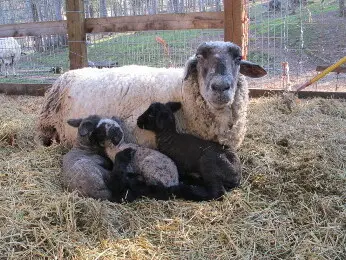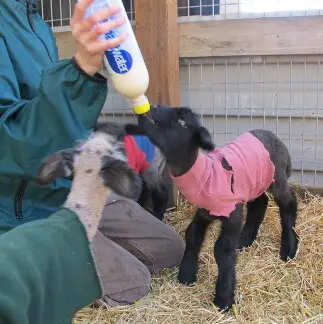Keeping Faith With Lilly
The passing of a herd queen
May 4, 2020

Lilly with her lambs
Walt:
Windward is not a farm; we don’t raise animals to sell. What we do is to develop a partnership with the animals who enable us to live sustainably on this land by converting things we can’t eat (grass, acorns, weeds, bugs, etc.) into the things we eat or use to sustain ourselves (eggs, milk, lard, wool).
Different animals eat different things, and by maintaining a diversity of animals, we’re able to increase productivity while limiting the demands on our ecosystem.
Sheep and goats play key roles in that process, and we share our home with animals who’ve earned a place here. In a commercial herd, does and ewes are usually sold off at around six years of age; in a sustainability herd, matriarchs such as Lilly and Sprinkle are honored and welcome to live out their lives here.
This was Lilly’s tenth birthing season, and it was clear that gestation was taking a toll on her. Still, she hung in and competently delivered her lambs like the pro she was. It was evident that the birthing had exhausted her, and we did what we could to make her comfortable in the hay barn surrounded by her lambs.
Lilly spent the day with her lambs, but the birthing stress had been too much for her—she passed during the night. Usually, the loss of the mother would mean the loss of the new born lambs too, but we were determined to rally to Lilly’s aide. So Sarah and I stepped up and became surrogate moms for her two girls (Lizzie and Dapple) and her boy (Sketch).
Giving birth is always a dicey proposition, and over the years, we’ve developed a well-stocked birthing kit which is a Good Thing when you live thirty miles from the farm store and a baby at risk is needing immediate care. We had to hope that they’d gotten enough colostrum from Lilly before she passed, but only time would tell. What we could do was swung into action and use a feeding tube to get milk into their bellies. That was important since they needed to have something to give them some energy to help them get through the night. Then, they each got a nifty jacket made from the sleeve of an old sweatshirt to help keep them warm.

Bottle feeding the lambs
The birthing pen was sheltered from the wind and well filled with fluffy straw so the lambs were able to nestle down together and cuddle up to keep each other warm. Mid-April nights can still be cold, but the lambs are much better off than if they had been born in February—which is when the sheep and goats would have given birth if they’d been left to their own devices last fall.
Because we keep the ewes and does apart from the ram and buck until Halloween, all the girls (two sheep and four goats) gave birth within a short time frame. Sarah took lead on bottle feeding the lambs while I took charge of the kids. It was “touch and go” for a while, but I’m pleased to report that we didn’t lose any of them.

Lizzie and Dapple cuddle as Sketch looks for something to nibble on
Three weeks later, here’s a pic of Lizzie (the black lamb) and Dapple curled up together for a nap after their noon bottle, while Sketch is nosing around in a tray nibbling on alfalfa leaves. You can see from the pic that Lilly’s lambs are chubby and growing fine.
Lilly and I had a special relationship in that most sheep are, well, sheepish, but Lilly took personal responsibility for the flock, and each morning we’d meet at the fence to check in. I’d have a slice of bread in my pocket and she’d let me know how things were going for her. I miss her a lot.
Lilly won’t be with us this year, but her lambs will grow up to carry on in her stead. And that’s life on the land, as births and deaths weave together in the Never Ending Dance.
